We were surprised and excited to receive an e-mail inviting us (Myself and my partner, Dean) The National Breeding Centre. This was as a thank you for doing some fund raising during the year so far.
I have been researching Guide Dogs UK for about seven months, since my interest in the possibility of being a suitable candidate to own a guide dog (Often referred to as little life changers). I started my application approximately six months ago, and am extremely excited to tell you that after lots of assessments I was successfully placed onto the waiting list, two months ago. So, I am eagerly waiting for that magical telephone call from Guide Dogs UK to say that they have found a potential match for me.
Disclaimer: Please note that this is MY own personal interpretation of this amazing day. The thoughts and writings are mine only and in no way is a direct representation from Guide Digs Uk themselves
Making our way to The Guide Dogs Breeding Centre – Warwickshire
It was a three hour journey from our home in West Yorkshire, and the drive was rather surprisingly hassle free. We arrived in good time. We actually stopped off at a nearby cafe (The Pavilion Cafe) for a very welcome and delicious Bacon and Mushroom Sandwich and cup of tea!
When we arrived at the location, we were so excited, and surprised at the sheer size of the facility. Our first impressions were of the immaculate grounds and presentation of the buildings. As we made our way from the car to the entrance (Dean acts as my sighted guide, I also have my long white cane), we heard dogs barking, and saw a staff member walking two beautiful dogs, a Labrador and a golden retriever I think.
We then noticed a lovely willow sculpture of a guide dog and their owner in the bushes, it was lovely:
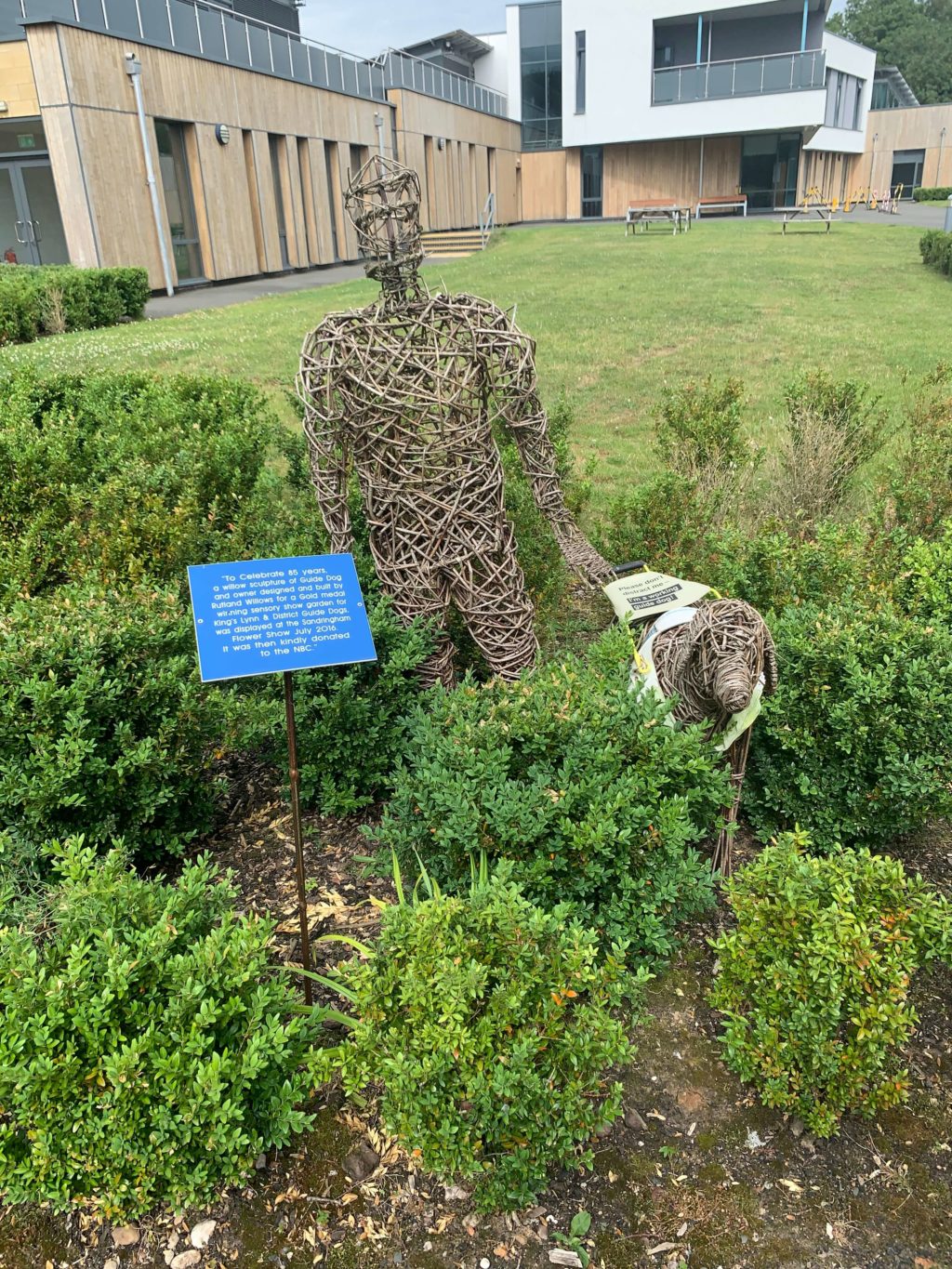
We then went into reception and was struck by how immaculate it was, I don’t know what I was expecting, but there was absolutely NO dog smells, and the walls were white with huge images of people and dogs in the Guide Dogs UK blue colour. The walls were curved and it was very spacious. As you would imagine, everything was accessible for everyone regardless of age or disability.
We were expected, Dean. signed in, and we were given our name badges and escorted upstairs to a large room where others had already began to gather. As soon as we entered, we were offered hot or cold drinks and biscuits by some of the guide dog volunteers. They were wonderfully friendly and chatty, and we were immediately made to feel welcome and at home. We mingled for a short while whilst everyone gathered and settled down. There were information folders on each seat, and they knew I was registered blind, so offered to send me e-mail visual or audio downloads, so that I didn’t miss out on any of the information. ( I will attach the download once I receive it next week for you to read if you’re interested.)
Unexpected presentation
The organiser, Ali thanked everyone for attending, and went through the programme for the day. She explained that by inviting us to the centre today, it was just Guide Dogs UK way of thanking us all for being a part of the guide dog family, and for raising vital funds for them. At this point, Ali announced that she would like to award some certificates for the fundraisers, and began calling peoples names out handing them a certificate. Each person stood up, received a round of applause and had their pictures taken. I don’t know why – but, I was shocked to hear my name being called too! I suddenly felt very proud.
Each member of staff and volunteers introduced themselves and told us a little bit about them and what they do pithing Guide dogs UK. It was so very interesting to hear the volunteers speak. Some of which were Brood Bitch Holders, or Stood Dog Holders. One chap had 47 puppies born at his home in the 35 years he has been volunteering! There were two litters due within the next 4 weeks from two of the volunteers with brood bitches – all very exciting.
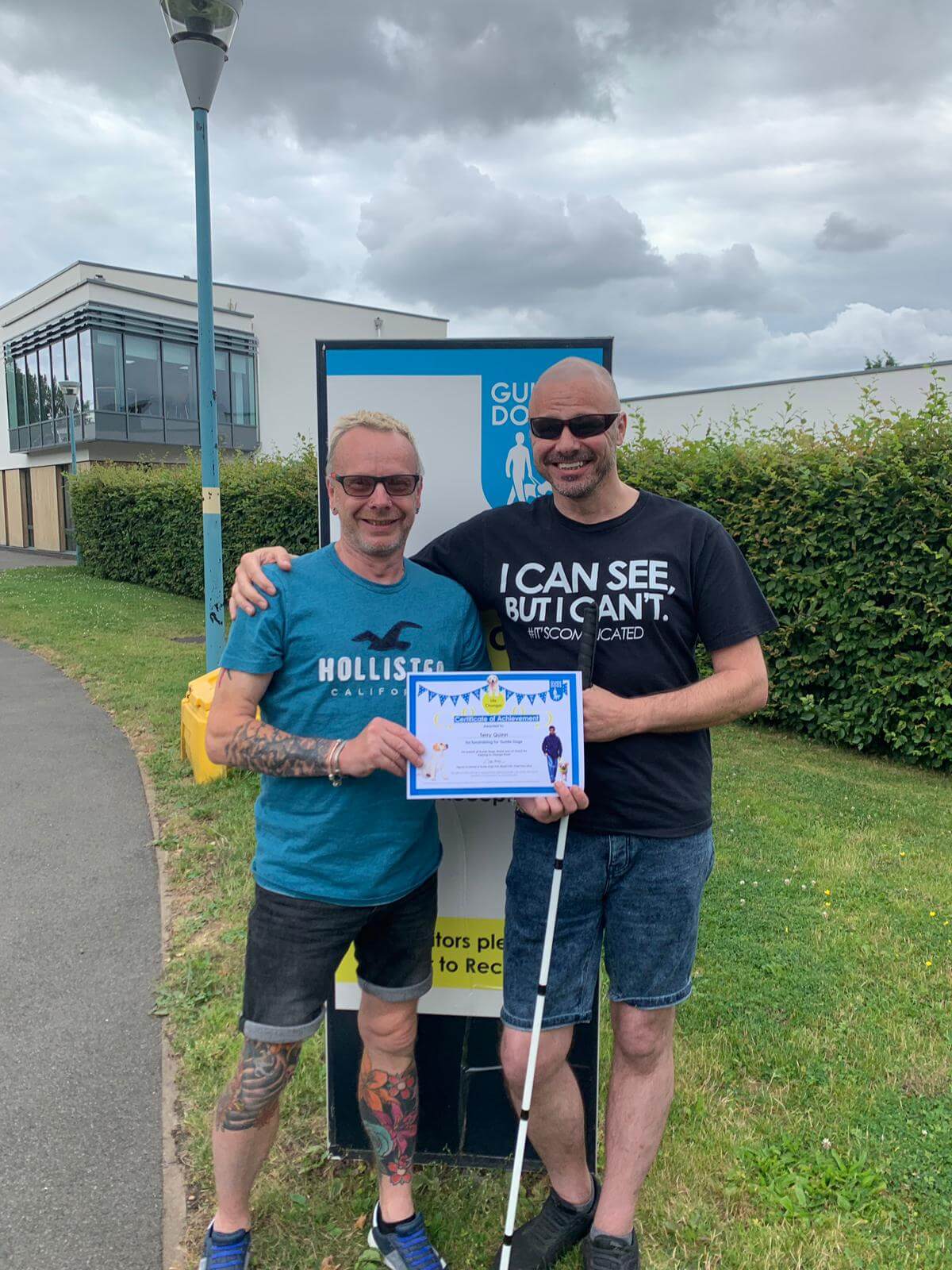
Tour of The Guide Dogs UK National Breeding Centre – Warwickshire
Outdoor view of puppy kennels and runs
We were divided into small groups and each group had two volunteer members that were going to take then for a tour of the facility. There was a real good spread of ages pithing each group from very young children, to the likes of Dean and I, being at the more “mature” end haha. We would first of all walk outside to see some fo the Kennel and Kennel runs. It was wonderful to see that there were lots of grassy areas for the pups to play in, with lots of toys and sensory structures. The runs faced the beautiful outdoor grassy areas. The runs were nicely shaded to make sure the elements didn’t affect them, whilst at the same time, letting them have there outdoor fresh air. Everything. had been thought of when building this centre, including the eco friendliness of it. The roofs of the kennel structures sloped downwards, and it was explained that this is so that they can collect and re-cycle the natural rain water. This would be used for washing out the kennels and runs. As you can imagine, lots of puppies produce lots or “waste”, so regular hosing down was the norm. Again, you could not smell any dog smells in the air at all – just lovely fresh air.
Indoor views of the puppy kennel areas
We then went inside to look at the kennel areas from from the inside. It was so spacious and had lots of enrichment areas. The puppies had lots of space to play around in and it was a very special place to see.
- full litters are kept in the same kennel space, to maximise interaction and familiarity
- all kennels faced into the centre, meaning that all puppies could see and communicate with each other at will, whilst at the same time seeing kennel staff supervising them
- There were TV’s playing things such as ceebeebies 🙂 !
- The puppies come here at around weeks of age for one week. During this time, they get individual attention and are fully health checked and assessed on things such as temperament, so cal interaction, alertness etc
- The puppies receive their first vaccinations
- At age 7 weeks, the puppies will be transported across the country to a vast group of very dedicated puppy walkers, who will then keep the puppies for around a year, learning them all of the basic skills. Exposing them to lots of different places, environments, noises and situations as well as getting them used to being on a lead and learning basic commands
Where are the puppies born and what happens to them?
Very few puppies are actually born at Guide Dogs Uk National Breeding Centre, Warwickshire. Most puppies are born in the volunteer Brood Bitch holders homes. They then stay with the brood bitch and owner for the first six weeks of their lives. This is the most natural environment, and allow the puppies to thrive from the colostrum and milk from their mothers, learn the basic nurturing characteristics and bond with each other. The brood bitch holders are very confident in the process of the bitches giving birth and raising the pups. Average litter sizes are around 7-8 puppies, but the largest litter so far has been 14!
There was actually a German Shepherd brood bitch just 3 days away from birthing at the facility when we were there. We were allowed to view her through a glass window on the strict instructions that everyone was silent, no banging on the windows, and that if at any stage she showed signs of distress, we would be immediately removed from the viewing area – quite rightly., She was beautiful. Just laid down, sleeping and looked so peaceful
The brood bitch holders have 24 hour access to Guide Dogs UK experts should they have any worries or concerns about the brood bitch herself, the pregnancy, birth or pups welfare. On occasion, a brood bitch will be brought to the facility rather than give birth at home. This could be for many reasons including, problematic pregnancy, concerns or possibly a situation has arisen the the brood bitch home that means it isn’t practical for them to birth there.
It is really important that the potential guide dog puppies leave at six weeks of age, as it is around this time that they begin to then learn “pet” behaviours. Whilst it is important that they learn their own species behaviour, if they are to make successful Guide Dog (Life changers), they need to learn more of the human behaviours’ s they will have an essential and extremely responsible position of keeping their owners safe. Only the best of the best will make it through to qualifying as a guide dog, and currently this is running at around 7 out of every 10 pups make it to the final stage. Any that do not make it all the way through are still very special dogs, but just not cut out for this role. They are given a career change, and this could be to train with another charity to be a service dog, medical alert dog maybe or an assistance dog. If this isn’t possible, they are found wonderful loving homes where they can live as an adored pet.
Our volunteer guides were both brood bitch holders, and were asked what it is like to have to let their adorable puppies go at 6 weeks. We smiled, because they both said that in all honesty, after giving them all 24 hours a day care and attention for the last six weeks, their noise and the normal frenetic puppy behaviour, they ( and the brood bitch herself) is generally happy to see them go, in the knowledge that they are now entering the next stage of their life in the hope of becoming a life saving Guide Dog for the Blind and Visually Impaired. Family life can then resume in their homes’ nd the brood bitch can get lots and lots of attention themselves and have a good rest from parenthood.
A typical brood bitch will have probably 4 litters in her lifetime, occasionally 5. This is of course full dependant on the brood bitch health an d wellbeing. They will not be continually bred if it isn’t in their interest to be. If there are ever any welfare or health concerns, these are fully investigated and considered before any future mating. Of course, it is essential that new brood bitches and stud dogs are Brought online throughout to replace those that retire. These are selected from the stock as they progress through their guide dog training, and only the creme de la creme are selected as brood bitch and stud dog. They are the fittest most healthy, with the best temperaments.
Here are some pictures of the puppies we saw:
On with the tour……
Guide Dog Harness
Looking at the Guide Dog harness was very interesting. I had seen and experienced one during my guide dog application, and I knew that If you see a guide dog in a. Brown harness, that’s the guide dog was still in advanced training. A White Harness means that the dog is a fully qualifies Guide Dog. The Red and White chequered harness means that the guide dog owner is both Blind or Visually Impaired AND Deaf. What I didn’t realise was that the very first white harness made was so complicated. It has so many straps and buckles, that someone with near perfect sight would struggle to get it on and off, so without sight or with impaired vision, it must have been damn near impossible.
Thankfully, today, the harness is very simple to put on and take off, with minimal straps and buckles. In fact, the guide dogs are trained to help the user. The guide dog owner simply holds the harness near the guide dog and he or she will place their head through the harness collar. the owner then simply fastens the underbelly strap, and het presto, you’re ready to go!
So what’s the purpose of the harness and what does it do?
In very simple terms, the harness is the guide dog and owners means of guiding.
- When the guide dog is NOT in harness. He or she is lime a pet dog. Will play with other pets, run around, be silly, engage with people – just like any regular pet.
- When the harness is on, it is like a light switch being flipped. The dog knows that he or she is now working to protect their owner with whom they have an amazing bond. Their sole purpose is to safely guide their owner, keeping them from danger. To guide them around obstacles, find certain things like a door, a chair, a counter, the kerb, steps, pedestrian crossing yellow box etc. To safely get the owner across the road and avoid any obstacles in their way throughout a journey. Their focus is solely on the guide dog owner. they will ignore other animals, not react to loud or sudden. noises or be distracted by food on the floor or any other distractions.
- If the harness handle is in the down position ( resting on the dogs back or slightly to the side ) then the guide dog is in ready mode.
- If the owner is holding the harness handle, the guide is working and will carry out their duties, take commands from the owner and guide them safely to their destination
The harnesses are made by talented craftsmen at Guide dogs. I think there is a team of four here at Warwickshire. Whilst they are all the same, they are tweaked to suit the individual dog and owner. Different length handles etc. The harness handle is extremely lightweight, and causes the guide no discomfort. There is no waste in materials, as off cuts are used to make leather bracelets/bangles, coasters and other trinkets. They also make harnesses for other guide dog associations across the globe.
The harness handle is amazingly important. It is through the handle that both he guide dog and their owner “feel” each other. The handle isn’t gripped at all, it is held lightly between the fingers of the left hand. The owner can feel the guides movement as they walk, they can interpret the direction that the dog is going, the speed at which they are going, if they are nervous or relaxed etc. The guide dog too can sense if their owner is nervous or tense, and where about they are in relation to each other. The owner will feel when the guide is taking them around an obstacle, or when they are at a kerb or stairs etc
Some Helpful Guide Dog In harness information:
- If you see a guide dog owner just stood, on their own, but with the harness handle down, looking around. They may be wanting help. If you see this, it would be great to approach the person, announcing that you are there, and asking them if they need any assistance/help. They may say oh, not thanks, Im fine, in which case, brilliant, just say no worries, just wanted to check. If they say, yes please, listen to what they say, and assist I anyway you can. However, DON’T distract the dog in any way by making eye contact with them, patting, stroking or talking to them. If you would like to touch the guide dog, please ask the owners permission first. They may say yes, BUT be prepared for them to say, not at the moment, because sh/she is working. If they do say this, please respect it, and don’t interact with the dog. If the dog looses focus on the owner, then they are not protecting them from harm.
- If you see a guide dog and their handler walking with the harness handle raised pleaseDO NOT EVER distract the dog in a ny way. Don’t make eye contact with it, speak to it, touch it, offer it food ar anything else it is working to keep its owner safe. A split second of loosing focus could put the owner in danger of being hurt, or both the dog and owner in danger.
- Sometimes of course, if appropriate the owner will say of course, and let you pet their guide dog. But, this is the exception and certainly not the rule. Even if the owner is sat in a coffee shop, and their guide is laying beside them or under the chair/table – don’t distract the, as you have no idea that the person may get up at that split second and if the guide os distracted with you, the owner may trip and fall.
- Please remember that whilst the guide dog is highly trained and is a put professional. At the end of the day, they are a dog. they aren’t robots, and if someone insists on trying to distract them, it is likely that they will succumb. So, please for the safety and well being of both guide and owner – Don’t do it.
Here are some photographs of the harnesses as described above. They are on stuffed toy dogs, to show the positioning and fit. One of the most adorable little boys on our tour just could not resist from eating to cuddle the dopga nd take him home haha
We then were shown long white canes, which I am very used to. And the main differences between a blind or visually impaired person using a long cane, and a guide dog.
Canes
There are various styles of canes for the blind and visually impaired.
Long white cane – This should be long enough to reach the sternum of the user. this then gives the person. using it two strides clearance before walking into something. So, for example, a cane user (me) will do a wide arc swipe of the cane along the ground in front of them. This is to maximise the possibility of the cane finding an object such as a kerb, obstacles, puddles, pot holes, wheely bins, stairs to name but a few. It is to try and locate what a sighted person can see when they walk. using it out in front of you, swiping from side to side should give you a two stride advantage. You can feel different surfaces with the cane, it is very tactile.
Te down sides of a cane are that you have to hit something before you know it is there, by doing so, you then know to navigate, around it. When you did stairs – if thew stairs are going up – you hold the cane loosely in front of you, like a pendulum, and as you walk, it will hit the step in front of you, so you can feel when to step up. When if doesn’t hit another step, you know your re at the top, and its slides on the floor. Going down stairs, you slide thew cane in front of you, and it will drop from step to step. You can then judge the height of the steps and when to take the next step down. When at the bottom of the stairs, it will simply slide forward – you then know there are no more stairs.
You will feel the textured bumps in the pavements before. The different bump patterns indicate different locations, such as approaching a pedestrian crossing
The long cane is universally white, which has a reflective coating, so that it can bee seen at night. However, these days, you can have custom made canes made in whatever colour or colour combination you feel like. There is a large debate going on about this, as there are two trains of thought. One being that it is universally recognised if you see someone with a white cane – you know that they are visually impaired, and may need assistance or at the very least, you Weill move out of their way – if someone uses a colour cane you won’t necessarily know the person to be visually impaired.
The second train of thought is that, well of course people will know the person is visually impaired, regardless of the colour, because of the swiping or tapping motions of the cane being used. Who else besides someone with sight issues would swing a cane on the pavement from side to side in front of them.
Some people sill sue the tap tap style of movement as opposed to the arc sweep
A Symbol cane
This is a cane that is much shorter and rather than been used as a method of guiding, it is carried in front of the visually impaired person, held across their chest. P{surely to symbolise to the public that they have a visual problem. people use this, because if they dont feel comfortable of confident using a long can or indeed feel they don’t yet need one just yet, it still alerts people to the fact that if they act a little weird by not walking in straight lines, or occasionally bumping into things, they aren’t drunk or weird – its just a failing visionary problem.
As with the guide dog harness – if a cane has RED as well as the white, it means that the user is both deaf and blind or visually impaired.
Guide Dogs of course are totally different, they are if you like The Rolls Royce of mobility aids. they are living beings constantly by your side. They will ensure that you walk around obstacles rather than hitting it and then navigating around it. They will judge if both you and they can get through a gap, and if this can’t happen, they will use their skills to try and find another way around it. However wonderful this is though – they bring with them a HUGE responsibility to the owner who can just hang them up and put them in a. corner when they arent walking about. they need to be groomed, fed and watered, cleaned up after, have regular health checks, be nurtured and continually trained got keep their skills up etc. So a guide dog isn’t for everyone.
A couple of people wishing our group then experienced using a long cane. they were blindfolded and guided to a corridor and asked to walk along it and find the end and walk across the adjacent corridor using the cane and their other senses. One of the volunteers then stood in front of the blindfolded person to see what happened when the blindfolded person name ac ross them with the cane. I think people found this extremely useful in experiencing this first hand.
The sensory tunnel !
Next on pout tour, the volunteers spoke of blind and visually impaired people having to rely on their other senses to navigate around safely, and what it must feel like. We all rely on our sight so much to perform basic everyday tasks. So, what must it be like for someone who is totally blind?
The group were given the opportunity to experience it first hand. Of course, there was absolutely NO pressure to do this if you didn’t want to for any reason. Some chose to do it, and others chose not to. I was really pleased that my partner Dean decided to do it, as he guides me every single day and he goes through my high and lows of being blind – HOWEVER, he has no practical experience of having very little or indeed NO sight, so he cannot fully understand. HE DOES NOW HAHA
Dean placed the blindfold on, and the volunteer led him to the entrance to the sensory tunnel. he was assured that there was nothing dangerous in there or anything which he could hurt himself on, but was asked to keep the blindfold on, and that there was zero lighting in the tunnel, and he simply had to make is way from one end to the other. One of the group very kindly guided m=e to the other end of the tunnel that Dean would be coming out from.
He did eventually emerge from the other end, and explained how strange it was and how nerving it was. he didn’t know what to expect, didn’t know what was to the die or front of him. One second his foot would be on firm ground, then the next on a different surface texture, like walking in grass or mud. he would feel things at the side of him that felt like tree branches and leaves etc. It was pretty scary.
Here are a few pictures of this?
Guide Dog Training Demonstration
This was the oooh, awwww, oh my god, how amazing is he part of the tour.
We were then taken into a large hall where there were lots of chairs for us to sit on. And of course we instantly noticed a member of staff sat on a chair with a beautiful dog beside him.
The Guide Dogs UK National head of training spoke too us. Talking us through the training programme. The training programme has been changed and is currently being rolled out to all Guide Dog centres. The Training Programme is called the S.T.E.P programme and stands for Standardised Training for Excellent Partnerships. Using Positive Reinforcement Training from start to finish.
Positive reinforcement has always been used, but it is just being standardised in its delivery. This ensures that the guide dogs learn well and are eager to please. Some dogs find no better reward than food, others verbal or physical praise, toys or other rewards. Food is used a lot during their training.
Once the trainee guide dog leaves their puppy raisers, they enter their advanced training, where their required skills to make a successful guide dog are taught. Some will make it, some will not. If they don’t, it doesn’t at all mean that they are viewed as failures – some will become brood bitches or stud dogs, others will be re-homes as a beloved pet.
No potential guide dog is forced to become a guide dog, if they dint want to train, don’t want to work, then there is little point in trying to make them do something that their nature is just not cut out for. People will sometimes say that its cruel to have a guide dog – a dog should be allowed to be a dog or that they look sad and miserable. This just is not the case:
- If a dog decides they no longer wish to work – they simply will stop and be retired, becoming a cherished pet dog. If a dog doesn’t want to work, their heart isn’t in it and no one wants to force them. These highly trained dogs LOVE to work, LOVE to keep their owner Safe and have the most amazing blind With them.
- The guide dog enjoys lots of work AND lots of play with their owner. When they are not in harness, they are like any other well behaved pet dog
- When someone says the guide ,looks miserable. That look on his or her face is focus. just like us when we are focusing on something, we take on that serious job in hand look. You can usually still see a happy wagging tail when workin
We were introduced to a gentleman called Merry, he was the Guide Dig Trainer we noticed, and his dog in training was called Barney. he was just seven weeks into his 16 week advanced training. When Barney wasn’t been dust for played with – we noticed he would simply lay down , close to his trainer. We learned that this behaviour is a learned behaviour. When the trainee guide doing isnt receiving active attention, then he will, assume the laying down position. Laying comfortably, keeping an eye on where his owner ism but not doing anything other than relaxing. This is important, because if the owner is sat in a. restaurant eating, or chatting with friends, or in a cinema, it isn’t appropriate for the dog to be trying to attract attention by jumping up, barking, running around etc.
Clicker training is used a lot, and one of the first exercises the dog is taught is target training, so for example, if the trainer olds out his hand/fist, the dog will go to it and touch it with its nose. Every time the dog does this, the clicker held in the trainers palm is clicked. The dog soon associates the clicking noise with a job well done and knows he will very quickly receive a reward. So a second or two later, the dog is given a piece ion his kibble. This is repeated over and over. Soon the dog is actively looking for whenever the trainer places his hand, at the side, in front, etc. He immediately goes to touch the trainers hand and that behaviour is positively reinforced by rewarding him with kibble. Over time, the trainer moves further away from the dog, and moves quicker. Positively reinforcing every time he gets it right.
The dog IS NOT reprimanded in any way if he doesn’t get it right. he just isn’t rewarded. This is a very powerful training. technique, and a simple one where the guide dog owner can continue the training and use it to target certain points throughout a journey.
For example, target training will be used to find the pedestrian crossing button, so the guide doing owner can locate it to press it. To find a door, a chair, a counter etc
Platform training is also amused. Where by a platform is placed on the floor and the dog is rewarded by a piece of kibble again every time they stand on the platform. Over time, the platform helps the dog to position their feet correctly for guiding the owner, being at the correct position at the side of and slightly in front of the owner.
A Chin Rest training technique is used to teach the dog that something is going to happen, and its ok, its not going to hurt them in any way. Place a tea towel on a chair, and very time the dog places his chin on the tea towel and rests there, he is rewarded with the click, quickly followed by the treat/kibble. repeating this over time, again the dog soon learns that by placing his chin in that position and keeping it there, will earn him a reward.
This is a very useful position who when the owner needs to groom the dog. Place the tea towel on the owners knee, the dog rests his chin there, which then allows the owner to know where the dog is and to groom him, check his eyes and ears, feel for any unexpected lumps or bumps etc. Administer treatments such as eye or ear drops safely without the dog moving about. Excellent training for the. the dog needs to go to the vets for routine or emergency visits
If the dog decides he wants to move his head from that position for any reason, then whatever action the vet or the owner was doing, immediately stops. So, it gives the dog a choice, he can choose to stay there and be rewarded or he can move, knowing he isn’t going to be punished or reprimanded. Most of the time, the dog will of course choose to stay there until whatever ie being Done finishes, as who doesn’t like a stroke or a massage etc.
These are just a few of the amazing training techniques and skills taught.
Training sessions are kept short 3-5 minute bursts. Its surprising how much can be achieved in this way. there is no point in trying to teach a dog when they start to loose their concentration.
They are taught to walk in straight lines, to recognise a kerb or a down curb , stairs etc and the these are found, they will stand or sit. The owner then know there is something there, and by the way they stand or sit and by feeling their position through the handle, the owner will know in general what they have stopped for.
The guide dogs in training are also learned something g called Obedient disobedience. Sounds crazy right?
What this means is that, whilst it is never the dogs decision as to wether it is safe to cross a road or not. The responsibility clearly lies with the owner, who will use their other senses, such as hearing to determine if there is incoming traffic. Should the owner make an error in judgement, and instruct the dog to walk forward , the dog will refuse to budge if there is a close vehicle or a speeding vehicle approaching. It will refuse to budge if it it is at say a steep drop, like a railway platform or hill top, because he will know that to move any further forward will put his owner in danger.
The guide dogs are extremely compliant, so, if a guide dog owner, finds that their guide dog will not follow their instruction, they know perfectly well that there is a very good reason for it, and they need to reassess the situation, and what they are asking their guide to do.
If the guide dog is asked to walk forward and it comes to a gap that both he and the owner cannot safely get through, again, the guide will stop. One way of resolving this, is to put your arms straight out and feel around, you may then feel an obstacle, such as a barrier. if you cannot assess what the issue is, you can ask the guide to find a way, and the dog will actively make a decision as to how to find an alternative safe way around it.
Tis doesn’t just apply to obstacles in front, below or to the side of you. A guide is highly trained in spacial awareness, so, they will avoinf you for example walking into overhanging trees etc. Something I am ALWAYS doing!
This is just the tip of the iceberg I have touched on regarding training.
here are a few pictures of Merry, the advanced training instructor and his amazing Guide Dog in training Barney.
Back to the conference room
We then had a good question nd answer session with out volunteer guides, which was brilliant, after which we went back to the conference room where we were treated to the most gorgeous sandwiches and cakes which were made by the Guide Dog staff and volunteers. Oh, they were delicious!
How being given the heavenly gift of a Guide Dog changed on persons life
We were so privileged to be able to listen first hand from a guide dog owner that believes she wouldn’t be here today of it wasn’t for this amazing charity.
This lady sat at the front, and told her story, it was both heartbreaking and heart-warming.
She was born blind in one eye, but soul see well in her other eye. She didn’t therefore go to any special school, as she could see well enough to be able to fully participate in typical school life.
Much to her surprise, she managed to get good grades and achieve her ambition of going to Oxford university. She was obviously very proud of herself and had the potential for a very happy and fulfilling life.
University went amazingly well, but then in her last year, she very suddenly lost her sight, completely in her one remaining functioning eye. It was such a devastating blow, as she could no longer see, she wasn’t able to continue studying. In those days and in the grand scheme of things, not that many years ago, technology wasn’t as it is now, and there weren’t the resources to deal with a blind person.
It was at that point that this young lady World fell apart. No one knew what to do with her. She was passed from pillar to post, from one institution to another. She became that depressed and isolated that she lost her ability to speak, het ability to communicate al all. She was confined to her room, and didn’t leave it for years – not to eat, not to socialise, not to wash etc. She was a recluse absolutely nothing to loom forward to. her life was merely in survival mode.
At the age of 30, she was to be placed into a permanent nursing home. She recalled opening the door, and seeing that everyone else was in their eighties or so, and yet here she was, at just 30 years of age. She spent the next 9 years in this nursing home, getting further and further into depression and exclusion. Yet, somewhere in her mind, from her earlier thought about exploring opportunities with a guide dog, she managed to bring these thoughts to the forefront of her mind again. However, she didn’t feel she was withe good enough, or would qualify for a guide dog.
She managed to pluck up the courage to make an enquiry over a long period of time. The rest is history, she hasn’t looked back. She is now a very articulate lady, a very intelligent lady who travels the country speaking for Guide Dogs. She has a fulfilling life with her furry companion by her side 24 hours a day. She feels that EVERYTHING is achievable, and is certainly proving this to be the case.
She is on her second guide dog now, and believes that each of her guides was given to her for a purpose, and ended at that point in her life. Each guide has given her different aspects of live and got her to where she is today. It was a heart wrenching abysmal story to hear, and the room was in total silence, listening to her every word. What an AMAZING lady, what an AMAZING Charity Guide Dogs UK is.
Guide Dogs UK is recognised as THE centre of excellence across Then World. people travel from other countries to learn Guide Dogs UK techniques and breeding programmes…truly inspirational.
My conclusion
I had the most amazing and inspiring day. I learned so much and witnessed so much. I witnessed the amazing passion of every single staff and volunteers member of Guide Dogs UK at this Breeding Centre. I saw the future guide dogs in the making. I was overwhelmed and inspired by what I saw and heard.
I was already super excited about my future, knowing I will be matched with a life changing Guide Dog of my own. Now, I am even MORE super excited looking forward to being able to feel like I can participate and contribute to society once again. I look forward to having the confidence and independence to step out of my front door by myself and to be able to feel free once again. Having freedom and allowing my rock, Dean to have some independence from me too is very important.
BUT
I am also very saddened that Guide Dogs UK relies solely on donations. They receive no Government funding whatsoever. These life changing Guide Dogs cost over £55000 each from their initial breeding to retirement from working life. That is a huge amount of money to find, to change just Ione persons life.
What can people do to help change someones life by allowing them the gift of freedom and independence in the form of a Guide Dog?
There are so many ways, there truly are, and not all are financial. So, everyone, who wishes to can take an active part in this amazing cause. here are some of the ways
- Leave something in your will. This is something I DID NOT know. But, Guide Dogs Uk offer. FREE simple will writing service to anyone aged 55 and over. So, not only are the charity and blind and visually impaired people benefitting. YOU are too by having your will written FREE of charge by a qualified solicitor, which in turn gives you the peace of mind that your family and loved ones are cared for too after you die. There is no set amount you have to leave in your will for Guide Dogs Uk, you don’t have to leave anything if you don’t want to (but why wouldn’t you?) Its simple to do…to find out how, click on FREE Guide Dogs UK Will Writing
- Sponsor a puppy. Sponsor one of the guide dog puppies from as little as £1 a month. You will receive “updates” and pictures of your puppy as they grow and develop. Can be paid up front or by monthly direct debit. To see how, click on the Sponsor a Guide Dog Puppy Link.
- Name a Guide Dog Puppy. This is really exciting. You can choose a name for the puppy that will follow him for life. You even get to meet your puppy, as well as receiving regular updates throughout his working life! This may seem like a lot of money, but it can be done in varying amounts, can be from an individual or a group or an entire organisation. To find out more, click on the Name. Guide Dog Pup Link
Another fantastic way you can help change a life is by:
- Volunteering with Guide Dogs UK. This doesn’t mean a permanent commitment. It can be an hour a week, a month a year! Or something much more regular, depending on your circumstances and what you want to do. But please don’t think, well, an hour of my time isn’t going to make a difference it really does…A HUGE difference. There are so many volunteer roles, you will be amazed. To see how you can volunteer, click the Become a Guide Dogs UK Volunteer link
I truly hope that you have enjoyed reading about my Guide Dogs UK National Breeding Centre – Warwickshire tour, and have learned a few things you were previously unaware of. I would LOVE to hear any comments you have., There is so much more to be said about Guide Dogs UK, but, You have the links, so please research it as much or as little as your interest allows.
MASSIVE thanks and gratitude to all involved from Volunteers and Guide Dogs UK staff, brood bitch and stud dog holders, puppy raisers, boarders , trainers and everyone else who plays a part – you are AMAZING.
I would LOVE to hear your comments and thoughts
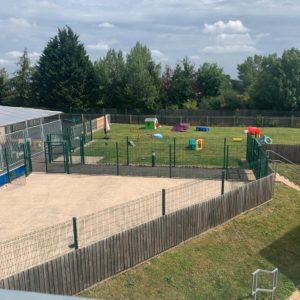


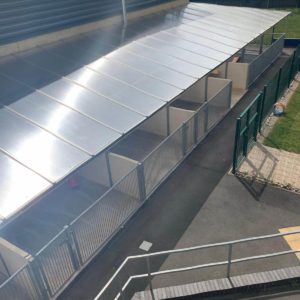
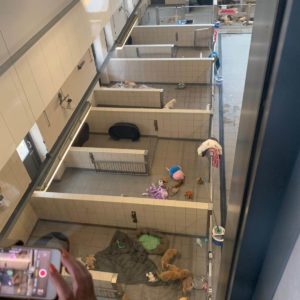

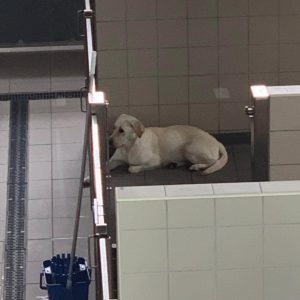

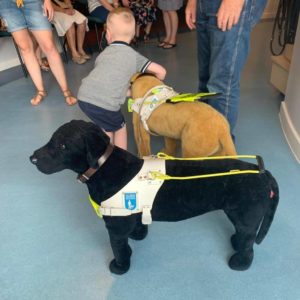
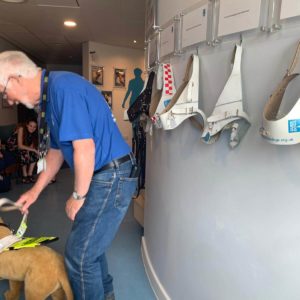
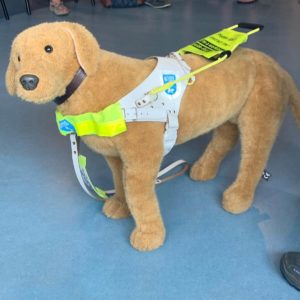
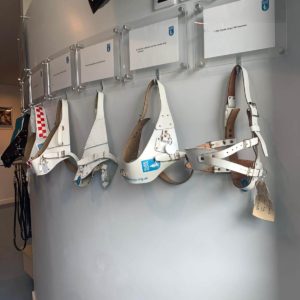
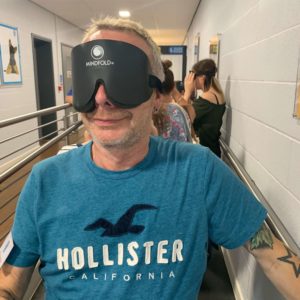

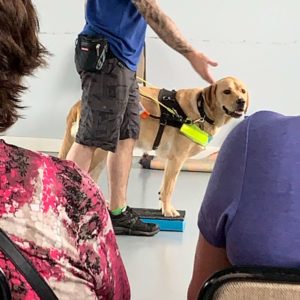
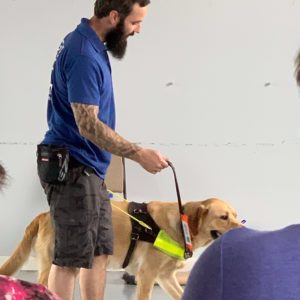
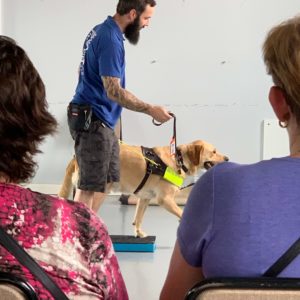

Terry – fascinating to read your blog and more so as you are a dear friend. Was so delighted when we first heard you would be getting a ‘life changer’ and you inspired each of us to make monthly donations. Cant wait to hear more of your journey xx
Thank you Angie, I am pleased you enjoyed reading about our experience last this wonderful place.I learned so much too, and it just reinforced what important roles all of the Guide Dogs family of staff and volunteers so selflessley do in order to bring a World of independence to those of us who feel we have lost it. Yours and Alans support as friends and supporters of Guide Dogs is truly appreciated
x x
Hi terry I have just read this whilst sitting under the dryer at my hairdressers. It is amazing.
I do hope you get a lovely furry friend to help you eventually and yes I will look at doing a donation.
Dean must also be praised. He is wonderful with you
Lots of love
Norma
Good morning Norma. Thank you so much for taking the time to read of our experience at Guide Dogs UK. It really was an inspiring day.I nav ely fingers firmly crossed that they find a match for me in the not too distant future. Dean is just so amazing in the way that he has adapted to my blindness. He instinctively helps me now in the way he knows works best for me – we also have lots of laughs about it with regard to my daft “blind moments” – and its all done in good spirits.
Thats so very kind of you to make a donation Norma – thank you so much. Hope all is good with you all
Terry x
What a lovely experience you have had at the breeding centre. I am glad it was accessible to you and it sounds like you are still buzzing from the day.
I am currently on my second dog and they open so so many doors for you. It is hard work, but worth it if you want to put in the work.
I really enjoyed reading your blog. PS i think you should become a speaker reading this post 🙂 fingers crossed you don’t have to wait too long to get your new partner 🙂
Torie
Thank you so much for your lovely comment.
I absolutely am still buzzing from our visit. Every time I thin k about Guide Dogs (Which is daily!) I get the same buzz.
I keep reading posts that say how long the waiting list is – so, I have to keep reminding myself that I will have a long wait – BUT, no matter the wait, I know it will be worth it,. as you say, it will open so many doors for me.
How fabulous that you are a seasoned Guide Dog owner and on your second guide.Its lovely to know people who have guides, and I cannot wait to join the GDO family.
I am a firm believer in the what you put in – you get out ten fold with so many things – so, it absolutely is worth the hard work for sure
P.S I would LOVE to become a Guide Dog Speaker. I feel so passionately about them and what they offer the visually impaired
Have a lovely weekend, and love to you and your guide
Terry
Hi Terry I am a guide dog owner who was born blind never had sight have one prosthetic eye and would not believe to be where I’m at today without the aid of my guide dogs . My current guide dog is Fisher and he is 5 1/2 and I will be working nearly 4 years coming up now it will be four years he was young as I always have young dogs I’m in my 30s and had Guide-dog since I was 18 my current guide dog is Fisher and he is 5 1/2 and I will be working nearly 4 years coming up now it will be four years he was young as I always have young dogs I’m in my 30s and had Guide-Dog since I was 18 I applied for my first one after finding sport and talking to some of them within the visually impaired community who had dogs they describe to me what and how the dog assisted you I grew up around dogs at that time I could not apply until I was 18 One of my dogs retired work for nine years I got off the train walked into a lamp post with my cane and went straight into a lamppost and I said where did that come from the person on the platform who works for the train company knew me and come up to me and said that been there all the time just Ronnie had guided you around it all these years and you didn’t even know they were there it’s yours what time dog is due to the point where you don’t even realise where things are. One of my dogs retired work for nine years I got off the train walked into a lamp post with me can and went straight into a lamppost and I said where did that come from the person on the platform who worked for the train company you me and come up to me and said that’s been there all the time just Ronnie had guided you around it all these years and you didn’t even know they were there it’s yours with them dogs do to the point where you don’t even realise way things are so I applied while in hospital after intensive care for my first guide dog I took my parents to the sports event over a few weekends so they could see the dogs working for themselves and they were all 48 . You don’t realise what the dog does for you until you really try the cane I always try to use it every week just to keep on my toes you never know when your dog me which I need to retire my last one retired because of cancer and then I was on the waiting list for a new one six months . My dogs have allowed me to travel with them all over I could not do that On cane my confidence was lower than what it is now on my first what a gift it is to receive a dog and what a privilege I hope your gift comes soon and it’s not long for you to receive . What is a good write-up I understand all of it with working dogs over the years and my last couple are always positive reinforcement they don’t even know the word no they never get it used one problem Michael is not with my dogs it’s a public because you do not tell the dog no they do not like it you’re not telling the dog off for being disobedience when it’s clear to me they’re not being disobedience they’re being intelligent and its safety is a problem for whatever I’m not going to tell my dog know when I know he/she is going to be doing their job to the best of their what is good writer I understand all of it with working dogs over the years and my last couple are always positive reinforcement they don’t even know the word no they never get it used one problem Michael is not with my dogs it’s the public because you do not tell the dog no they do not like it you’re not telling the dog off of being disobedient when it’s clear to me that not being disobedient there be an intelligent and its safety is a problem for what ever I’m not going to tell my dog know when I know he/she is going to be doing their job to the best of their ability but some people I’ve explained don’t seem to understand the concept of ignoring bad behaviour But like I said all my dogs have gone for them I would always recommend a dog over A cane The dog I have now has got a thing for the gate will come down above you and he will wait until they have come down he will not go across or anything by the train it’s an absolute refusal sit down to nothing weight and that he will do I’ve asked my dog not knowing of electric vehicles to go across the road and he will not go total refusal which is brilliant because sighted people thought when I give the command I was going to walk out in front of these oncoming cars
Hi Maxine. Lovely to receive your comment – thanks so much for taking the time, it is much appreciated.
It is great to gear about your guide dogs, and the difference they have made to your life. It sounds like I have a great deal to look forward to. Since loosing my sight, I have realised just how much I took for granted. Like you say, about avoiding obstacles, such as lamp posts and making sure you get across the road safely. As a sighted person, we just don’t think about these, we just naturally do it.
As a blind person, these things are no longer obvious to us, and the simplest of things can put us in real danger. So, having one of these amazing life changing guide dogs is a true gift.
You must have made amazing bonds with your guide dogs, trusting each other totally. I think nk you are absolutely correct in keeping your cane skills up. You never know when your guide dog may be temporarily unable to work.
I hear what you are saying about some people perceptions of a guide dogs behaviour. To be honest with you, un til I started on my application for a guise sig, I didn’t truly understand exactly their role. I knew nothing of them being trained to disobey your command if they felt it unsafe to carry this command out – (Intelligent Disobedience). Positive reinforcement is absolutely the way to go and to make sure the guide dog continues to do their amazing job in keeping us safe.
I loved hearing about you and your lovely guide dogs, and am so happy that you are able to get out and about together.I am pleased you enjoyed reading my blog post and once again, thanks for taking the time to comment.
Take care, and one day, I hope to swop guide dog stories with you, when I have mine by my side too ????
Terry